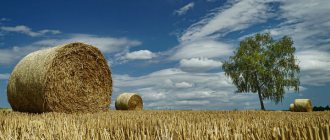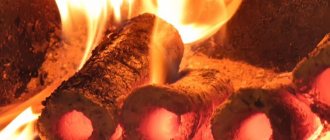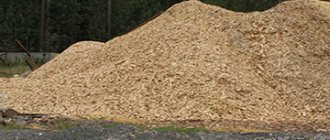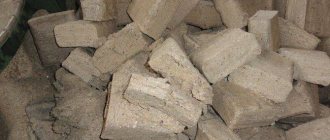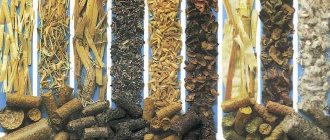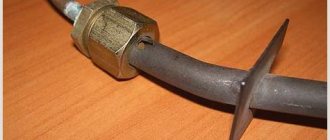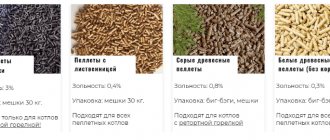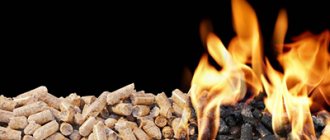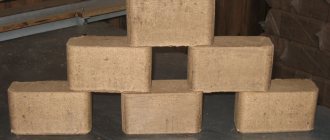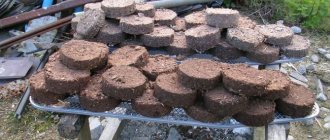This amount at various oil plants can reach tens of tons per week.
Disposal of husks has always been a problem: due to their low bulk density, transporting the waste to a landfill is expensive. During storage, it can easily ignite and also smolder, spreading an unpleasant odor. A certain amount of it is used as fertilizer and to loosen the soil.
However, sunflower husks have such an invaluable property as high calorific value during combustion
.
It is this quality that makes it one of the most efficient types of fuel, which is produced in the form of fuel briquettes and granules (pellets)
. Granulation is one of the most common methods of processing husks, which results in product moisture content of up to 12% and compression of the original volume by 5-10 times.
Advantages of sunflower husk pellets over other types of fuel:
- Heat transfer is 17000-19000 kJ per kilogram
. This is more than the average indicators of wood and approximately the same amount of heat that some types of coal give off when burning.
- 2 tons of sunflower husk pellets emit as much heat as 3.2 tons of wood fuel, 957 m3 of gas, 1000 liters of diesel fuel or 1370 liters of fuel oil.
- Combustion of pellets is energy efficient, usually the amount of unburnable residue (ash content) does not exceed 3%
.
- When burning no harmful substances are released
.
- The granules have no pores, which prevents them from self-ignition.
- Sunflower husk – cheap raw materials
, which oil factories are interested in selling so as not to incur disposal costs.
Reviews of Pini-Kay briquettes
Pini-Kay fuel briquettes, reviews of which in most cases are only positive, are distinguished by the fact that they do not stain the surface that comes into contact with them during transportation and storage. High density can also be distinguished, which is equivalent to 1200 kg/cubic meter.
Ash content can reach 3%, which is one of the lowest values. If we additionally talk about density, then it is 2.5 times higher than this parameter characteristic of wood. The bulk density of the material is 1000 kg/cubic meter. These figures are of interest to consumers quite often; buyers compare this indicator with bulk density, which is 300 kg/cub.m. This indicator, according to the owners of heating equipment, makes it easy to transport material over impressive distances. Thanks to the ideal shape, as well as small dimensions, it is possible to tightly stack the briquettes on pallets, pouring them through special sleeves if necessary. This allows you to fully automate the process of loading and unloading, as well as further combustion of this type of fuel.
Pini-Kay fuel briquettes, reviews of which you will become aware of after reading the article, should be stored separately from other substances and materials. If the conditions are met, the products can be stored indefinitely until the time of use. The temperature in the indoor warehouse should be equal to the limit from +5 to +40 degrees. In this case, the relative humidity can vary from 30 to 80%. Interaction of products with water and aggressive substances should be avoided. Consumers claim that to extend shelf life it is necessary to exclude exposure to ultraviolet radiation.
Sunflower husk granulation technology
When making pellets from sunflower husks, the usual algorithm for fuel pellets is used.
The required humidity of the husk is up to 14.5%
. Under normal storage conditions it is already dry enough for granulation.
1. Grinding raw materials in a crusher to a fine fraction.
2. The crushed raw materials go into a storage hopper before granulation.
3. The mass evenly enters the granulator, where it is moistened with water in the mixer-conditioner, after which it is fed into the pressing chamber, from the matrix of which granules subsequently emerge.
4. Since the granules are pressed at high temperatures, they are sent through a conveyor to a cooling column, where they are cooled and screened to separate non-granular particles.
5. Next, the pellets enter the storage bin or are immediately packaged into bags or big bags using a weighing dispenser.
Reviews about RUF briquettes
RUF fuel briquettes, reviews of which correspond to the characteristics of the material, are easily decomposed. Owners of fireplaces, boilers, and stoves note that when using another type of fuel, they have to turn into a fireman, ensuring that fuel is added every hour. In order to ensure smoldering, you need to reduce the draft by closing the vent. When melting the equipment, you need to ensure a slight draft, then a cold plug will be formed in the chimney, and the briquette will not smoke.
In this case, it is possible to melt the device without preheating the air duct. Using RUF fuel briquettes, reviews of which will be useful to read before visiting the store, you can warm up the room in a shorter time than using traditional firewood.
Features and disadvantages of husk granules
is characterized by increased oiliness compared to sawdust
.
If a granulator produces high-quality wood pellets, husk pellets from the same matrix may have an uneven surface and insufficient density. This material requires matrices with a high degree of compression
.
Seed husk granules have a higher ash content
than from wood.
This drawback most worries users of pellet boilers on forums. The ash content of husks is usually estimated at 1-3%, although according to some reviews it can reach 5-7%
. Surprisingly, sunflower seed husks grown in different soils may leave different amounts of unburnable residue due to the different mineral composition of the soil.
Due to the higher ash content, owners have to take better care of their boilers
: Clean the ash pan many times more often, check if the chimney is clogged. However, the price of such pellets is one and a half times cheaper than their wood counterparts. Therefore, consumer choice often depends on the level of laziness or the cost of delivery. Geographically, sunflower pellets are more available in the southern and central parts of Russia.
Moreover, even the ash of sunflower husks is not waste
: It is successfully used to fertilize the soil. Homeowners in rural areas accumulate it to use in gardening in the summer.
Reviews about burning time
If you decide to purchase fuel briquettes, it is recommended to read reviews about them before going to the store. It is important to take into account that these products, as noted by consumers, are characterized by a significant burning time, which is especially evident when compared with traditional firewood. Thus, loading into heating equipment can be done 3 times less often. Combustion occurs with minimal smoke formation, the material does not spark or shoot. This ensures a constant temperature throughout the entire combustion period. After combustion, charcoal is formed, which is also true for ordinary firewood. In the future, the combustion product can be used for grilling or cooking kebabs.
Prices for sunflower husk pellets
The average price of sunflower husk pellets is 3000-4500 rubles
per ton.
Wholesale prices are much lower; you can find offers starting from 1,500 rubles. Industrial enterprises purchase such fuel in bulk; this is typical for European countries. In Europe, this product costs about 105 euros
per ton.
Additional features of RUF briquettes
In shape, these products resemble bricks, in the manufacture of which minimum requirements are imposed on the qualifications of personnel and the organization of production, which has a positive effect on the cost of the product. Among the disadvantages, we can highlight the least resistance among all other briquettes to moisture and external mechanical influences. Therefore, this brand of fuel requires high-quality packaging; if it is damaged, long-term transportation and storage become impossible. This is especially true for CIS roads, the level of which does not correspond to European ones.
Characteristics of sunflower husk pellets
As already mentioned, the characteristics may be heterogeneous depending on the area where the sunflower grows and the method of preparing the raw materials, as well as the technology used.
Here are the characteristics of sunflower husk pellets
— a batch from Ukraine, certified according to the international standard EN plus.
- Humidity: 9.71%
- Ash content: 1.31%
- Sulfur content: 0.03%
- Density: 1.054 grams per cm3
- Total energy value: 21.43 mJ/kg, 5118 kcal/kg, 5.95 kW/h
- Energy value at work: 19.35 mJ/kg, 4622 kcal/kg, 5.38 kW/hour
Reviews of reed briquettes
If you are interested in fuel briquettes made from reeds - who fired them, reviews and other information - you can read all this below. Buyers claim that 1 kilogram of material will be enough for 7 hours of continuous burning. In this case, the heat transfer will be 6550 kcal/kg. Owners of boiler equipment say that they will only have to clean the device once every two years. The resulting ash, like coal, can be used as an environmentally friendly fertilizer.
You can ensure autonomy by using such fuel, since the equipment will not depend on companies supplying electricity and gas. There is no dependence on external conditions such as damage to pipelines, power lines, theft, etc. Consumers do not face the need for lengthy approvals, which are carried out before connecting electrical or gas equipment.
Fuel briquettes made of reeds, reviews of which have something in common with positive characteristics, have a high density. The production process uses technology that involves screw pressing. As a result, it is possible to achieve a density ranging from 1.1 to 1.2 t/m3. The surface consists of a fairly strong crust, which prevents damage and rupture of the briquette during transportation and storage. Transportation can be carried out by laying the products in two tiers, since the material almost does not form crumbs. The existing crust can reduce the penetration of moisture inside, which makes the use of briquettes more comfortable.
Reviews about Nestro briquettes
Nestro fuel briquettes, reviews of which will become known to you if you read the information below, have a wide range of uses. They are used when it is necessary to operate industrial equipment, as well as in railway transport. The bars can have an 8-sided shape with a hole located inside. The length of the product is 250 millimeters, while the cross-section is square and has a side within 65 millimeters. The diameter of the circle is equivalent to 70 millimeters, and the hole has a diameter of 20 mm. The humidity of the product upon delivery should not exceed 9%, while the maximum value varies within 7%. Ash content is minimal and amounts to 0.5%.
Consumers like the presence of a technological hole inside the products, which contribute to more intense combustion, without requiring forced ventilation. This makes it possible to use fuel in equipment that has low thrust. The products are manufactured using the technology of shock-mechanical pressing of husks and sawdust. The main difference between such briquettes is the absence of treatment under the influence of temperature during pressing. If there is a need to use briquettes of a certain shape, then these requirements can be taken into account by the manufacturer.
Manufacturing is carried out using connecting rod mechanical or hydraulic presses. Fuel quite often has a cylindrical shape, and among the negative and positive characteristics one can highlight the same features that are characteristic of RUF brand materials. The cost of such products is relatively low due to the fact that the production process is inexpensive. Consumers note that from the point of view of technical features, these briquettes are inferior in many qualities to Pini & Kay brand fuel.
